neutral to marginally beneficial; feeds on small invertebrates in bee nests
Ereynetes Berlese, 1883
Superorder Acariformes » Order Trombidiformes » Suborder Prostigmata » Infraorder Eupodina » Family Ereynetidae » Genus Ereynetes
Acarus limacum non Linnaeus, 1758 (=Ereynetes galeatus Berlese, 1923)
Adult: PalpsPalp:
Second (after chelicera) paired appendage of the gnathosoma. Has a sensory function, but may be variously modified for other functions (e.g., raptorial, attachment to host, or filtering).
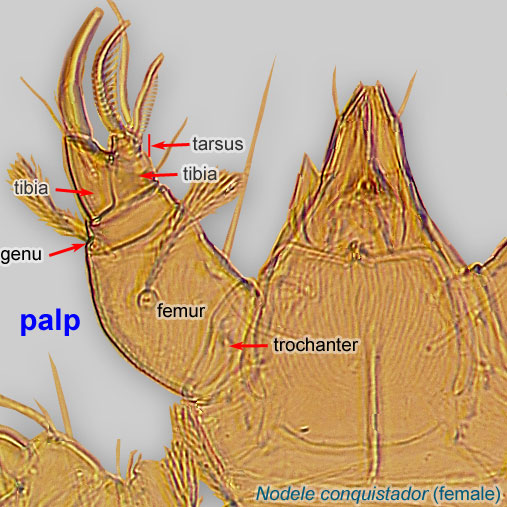 5-segmented (Fig. 1). Tarsustarsus:
5-segmented (Fig. 1). Tarsustarsus:
Terminal segment (also known as podomere or palpomere) of legs or palps. In Parasitoformes it can be subdivided into telotarsus and basitarsus.
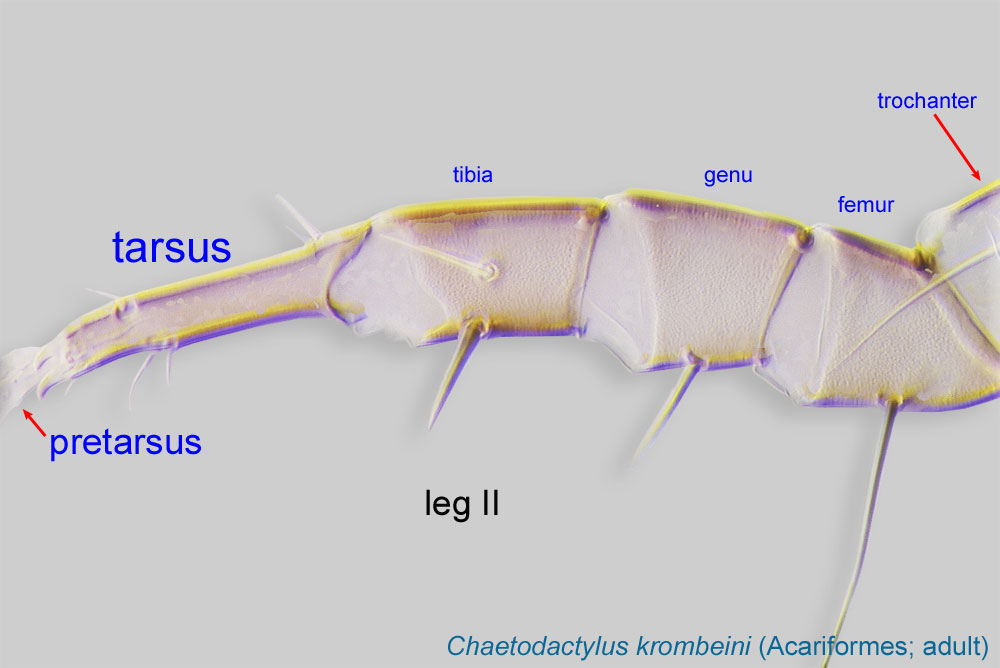 I with I recumbent solenidionsolenidion:
I with I recumbent solenidionsolenidion:
Thin-walled, terminally rounded or pointed filiform or peglike structure that is not birefringent in polarized light (unlike common setae in Acariformes). Often appears striated because of its internal structure. Found on the palpal tarsus on the gnathosoma and may also occur on the tarsus and tibia, less frequently on the genu, and occasionally on the femur of legs I-IV. In Acariformes, leg solenidia often arise from unsclerotized areas.
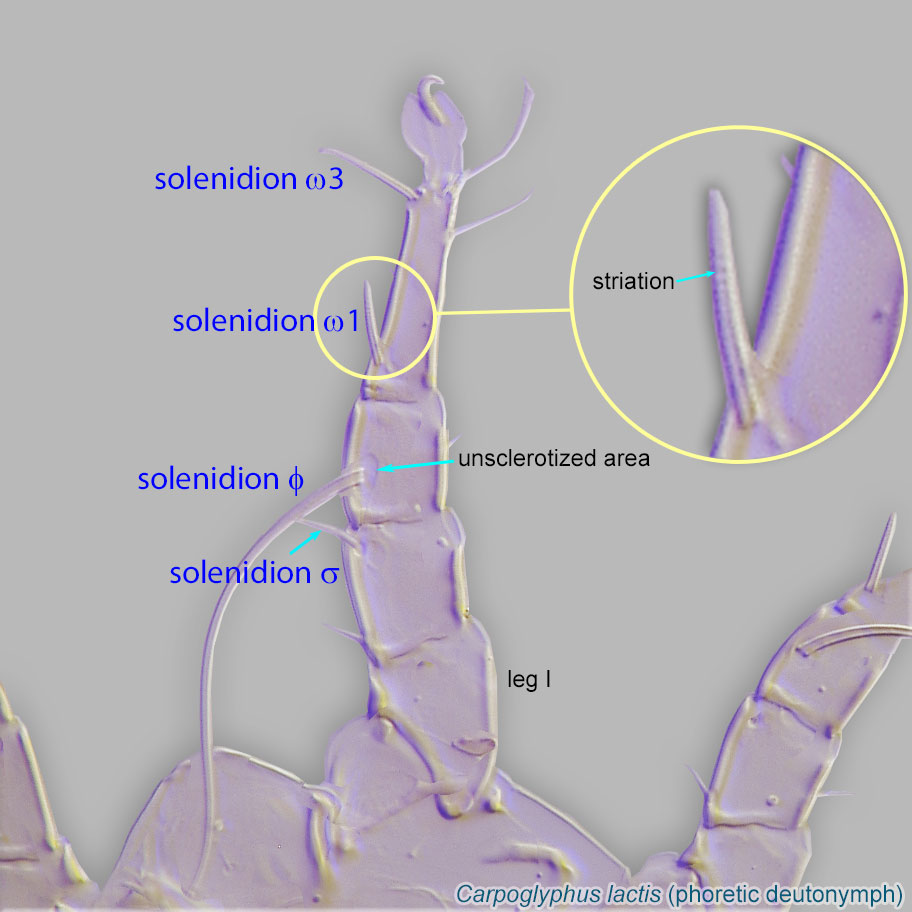 (Figs. 1, 3). Tibiatibia:
(Figs. 1, 3). Tibiatibia:
Leg or palp segment (also known as podomere or palpomere) between tarsus and genu.
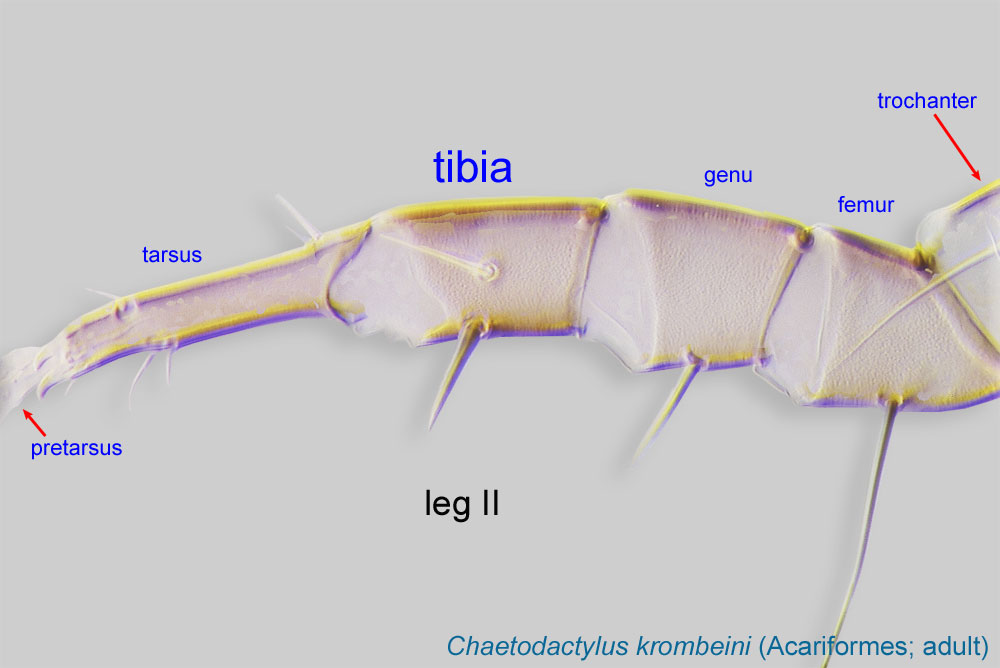 I with deeply recessed solenidionsolenidion:
I with deeply recessed solenidionsolenidion:
Thin-walled, terminally rounded or pointed filiform or peglike structure that is not birefringent in polarized light (unlike common setae in Acariformes). Often appears striated because of its internal structure. Found on the palpal tarsus on the gnathosoma and may also occur on the tarsus and tibia, less frequently on the genu, and occasionally on the femur of legs I-IV. In Acariformes, leg solenidia often arise from unsclerotized areas.
 in sac-like structure connecting to surface by narrow duct (Fig. 3). Femurfemur:
in sac-like structure connecting to surface by narrow duct (Fig. 3). Femurfemur:
Leg or palp segment (also known as podomere or palpomere) between genu and trochanter. In ParasitIformes can be subdivided into telofemur and basifemur.
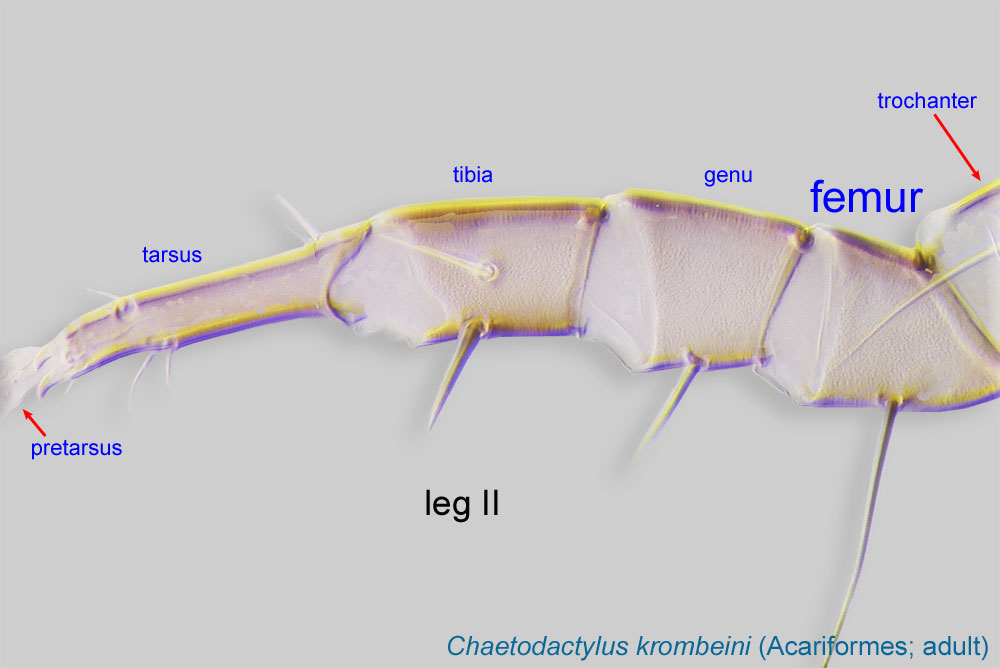 I with 7 setae (Figs. 1, 2). Prodorsumprodorsum:
I with 7 setae (Figs. 1, 2). Prodorsumprodorsum:
Dorsal surface of propodosoma.
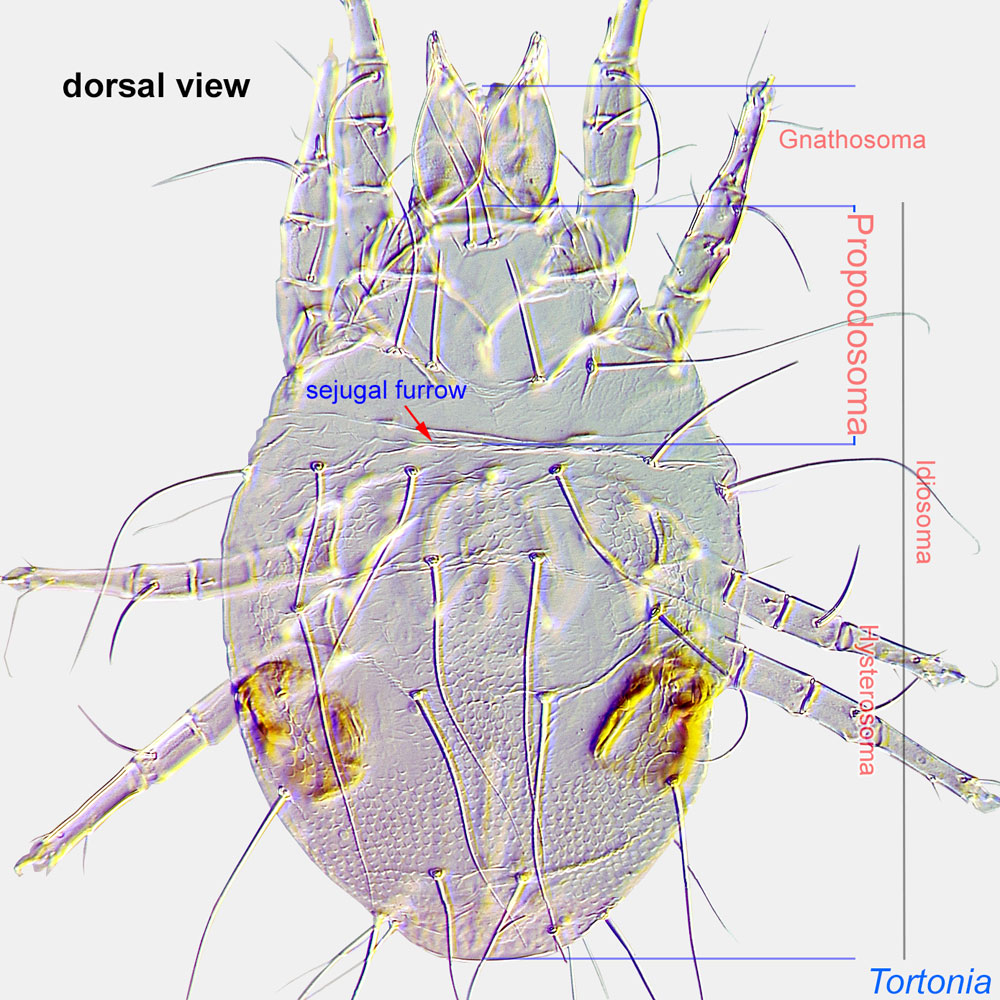 and legs with netlike ornamentation (Figs. 1, 3, 4). Posterior opisthosomal trichobothriatrichobothrium:
and legs with netlike ornamentation (Figs. 1, 3, 4). Posterior opisthosomal trichobothriatrichobothrium:
Modified seta that can be distinguished from true seta by its distinct large socket (complex cup-like cavity), and often, shape (which may be filiform, ciliate, pectinate, or thickened or clubbed). Present in many Acariformes (except Astigmata) and Opilioacarida (Parasitiformes). When paired and situated on the propodosoma, termed "prodorsal."
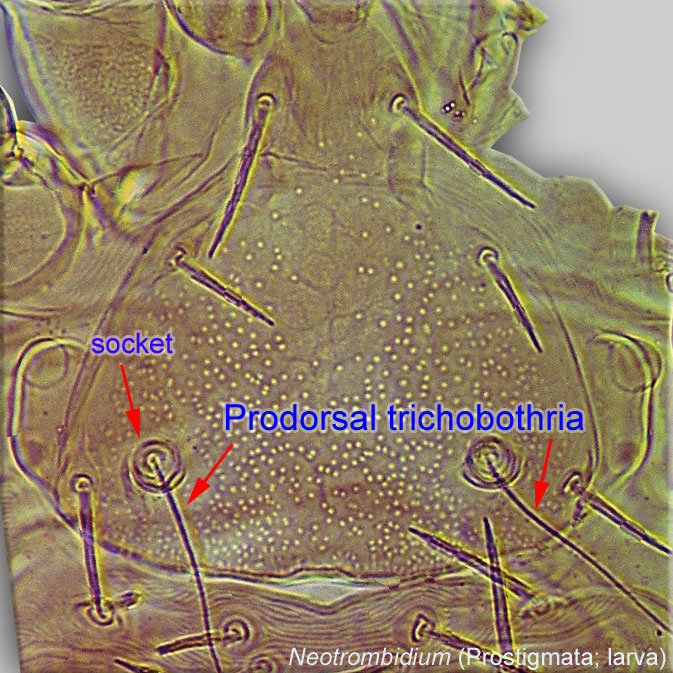 present (Fig. 1). Two pairs of genital papillaegenital papilla:
present (Fig. 1). Two pairs of genital papillaegenital papilla:
Paired, eversible, finger- or bell-shaped structures situated under the genital valves (in the progenital chamber) of many Acariformes, which serve for osmoregulation. In feeding stages of Histiostomatidae (but not phoretic deutonymphs) these are modified to cuticular rings situated externally on the ventral body.
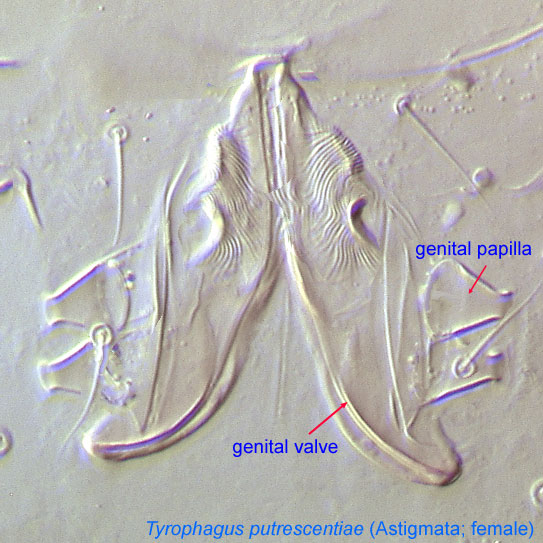 in adults (Figs. 2, 5).
in adults (Figs. 2, 5).
A dichotomous key to North American species is available in Hunter and Cross, 1968Cross, 1968:
Cross, E. A. 1968. Descriptions of three new species of mites phoretic upon native bees. Southwestern Naturalist. 13: 325-334., which can be used as a starting point. An annotated list of described species is given in Fain and Camerik, 1994Fain and Camerik, 1994:
Fain, A. amp; A. M. Camerik. 1994. Notes on the mites of the genus Ereynetes Berlese (Acari: Ereynetinae), with description of five new species from South Africa. Bulletin de l'Institut Royal des Sciences Naturelles de Belgique Entomologie.64: 145-164.. A key to the two species associated with bees is available from the bee-associated mites website.
Nearctic, Palaearctic, Neotropical, Oriental, Australian, and Afrotropical regions. Bee-associated species have been found in the Nearctic and Neotropical regions.
Mites of bee hosts found in nests only: Melipona scutellaris and Nomia melanderi.
facultativefacultative:
can complete entire life cycle without bees or their close relative, wasps
This genus includes five subgenera and 51 species of free-living predators that live in mosses, lichens, leaf litter, bat guano, dung, scarabaeid beetles, nests of mammals and birds, rotting wood, galleries of bark beetles, and under bark (Fain and Camerik, 1994Fain and Camerik, 1994:
Fain, A. amp; A. M. Camerik. 1994. Notes on the mites of the genus Ereynetes Berlese (Acari: Ereynetinae), with description of five new species from South Africa. Bulletin de l'Institut Royal des Sciences Naturelles de Belgique Entomologie.64: 145-164.). Two subgenera and two species have been found in nests of bees: Ereynetes (Anereynetes) meliponae Flechtmann, Fain, and Leal, 1985 (ex Melipona scutellaris, Brazil) and Ereynetes (Ereynetes) boharti Hunter and Cross, 1968Cross, 1968:
Cross, E. A. 1968. Descriptions of three new species of mites phoretic upon native bees. Southwestern Naturalist. 13: 325-334. (ex Nomia melanderi, USA). They are probably not specific to bees and may come from the outside environment in search of prey (small invertebrates). For example, Ereynetes boharti preys on acarid mites Sancassania boharti normally occurring in nests of bees of the genus Nomia.
Females or nymphs of some species have been found phoreticphoretic:
Pertaining to phoresy; using another organism (i.e., a host) for dispersal to new habitats. Phoresy can be distinguished from parasitism because feeding typically does not occur during phoresy.
on dung beetles, flies, and darkwinged fungus gnats (Fain and Camerik, 1994Fain and Camerik, 1994:
Fain, A. amp; A. M. Camerik. 1994. Notes on the mites of the genus Ereynetes Berlese (Acari: Ereynetinae), with description of five new species from South Africa. Bulletin de l'Institut Royal des Sciences Naturelles de Belgique Entomologie.64: 145-164.). A few species are permanentpermanent:
associated exclusively with bees or their close relative, wasps; cannot live without these hosts
associates of hermit crabs (Coenobita).